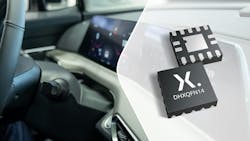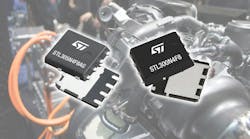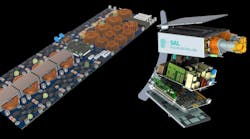Fixed-Direction Voltage Level Translators Cut Power Consumption and Pin Count
A novel family of advanced fixed-direction voltage level translators developed by Nexperia targets the most common push-pull data interfaces (including UART, SPI, and JTAG protocols) as well as general-purpose input/output (GPIO).
The NXU series of 4-, 2-, and 1-bit dual-supply buffers offer a smaller, higher-performance, and lower-cost level-translation solution that simplifies communication between a host processor and peripheral I/O devices when compared to existing designs. Their many applications range from consumer and industrial to automotive and enterprise.
The level translators address several problems found in comparable direction-controlled varieties, which typically require an additional GPIO pin for direction control. Such a requirement increases device size while also consuming some of the host processor’s scarce I/O resources. Conventional auto-direction devices don’t require a GPIO pin, but they usually lack the current drive required by many applications and sometimes exhibit non-deterministic I/O behaviors that can be a time sink to debug.
Devices in Nexperia’s NXU family combine the parametric performance capabilities of direction-controlled translation devices (i.e., high data rate, high drive strength, and glitch-free power sequencing) with the lower pin-out and size advantages of auto-direction devices. They also have a wider supply voltage range (0.9 to 5.5 V), consume less power, and support higher data rates (up to 250 Mb/s) than other voltage translation solutions.
To learn more about Nexperia’s voltage translation solutions, click here.
Next in This Issue of PowerBites
More PowerBites
About the Author
Lee Goldberg
Contributing Editor
Lee Goldberg is a self-identified “Recovering Engineer,” Maker/Hacker, Green-Tech Maven, Aviator, Gadfly, and Geek Dad. He spent the first 18 years of his career helping design microprocessors, embedded systems, renewable energy applications, and the occasional interplanetary spacecraft. After trading his ‘scope and soldering iron for a keyboard and a second career as a tech journalist, he’s spent the next two decades at several print and online engineering publications.
Lee’s current focus is power electronics, especially the technologies involved with energy efficiency, energy management, and renewable energy. This dovetails with his coverage of sustainable technologies and various environmental and social issues within the engineering community that he began in 1996. Lee also covers 3D printers, open-source hardware, and other Maker/Hacker technologies.
Lee holds a BSEE in Electrical Engineering from Thomas Edison College, and participated in a colloquium on technology, society, and the environment at Goddard College’s Institute for Social Ecology. His book, “Green Electronics/Green Bottom Line - A Commonsense Guide To Environmentally Responsible Engineering and Management,” was published by Newnes Press.
Lee, his wife Catherine, and his daughter Anwyn currently reside in the outskirts of Princeton N.J., where they masquerade as a typical suburban family.
Lee also writes the regular PowerBites series.





